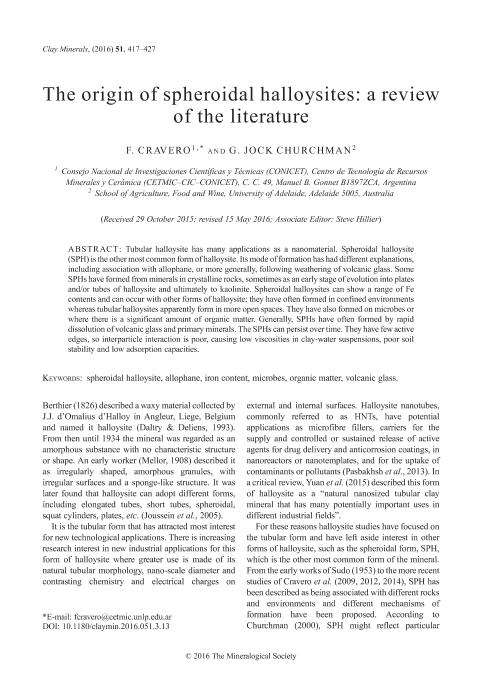Mostrar el registro sencillo del ítem
dc.contributor.author
Cravero, Maria Fernanda

dc.contributor.author
Jock Churchman, G.
dc.date.available
2018-06-18T20:47:59Z
dc.date.issued
2016-06
dc.identifier.citation
Cravero, Maria Fernanda; Jock Churchman, G.; The origin of spheroidal halloysites: A review of the literature; Mineralogical Soc; Clay Minerals (print); 51; 3; 6-2016; 417-427
dc.identifier.issn
0009-8558
dc.identifier.uri
http://hdl.handle.net/11336/49148
dc.description.abstract
Tubular halloysite has many applications as a nanomaterial. Spheroidal halloysite (SPH) is the other most common form of halloysite. Its mode of formation has had different explanations, including association with allophane, or more generally, following weathering of volcanic glass. Some SPHs have formed from minerals in crystalline rocks, sometimes as an early stage of evolution into plates and/or tubes of halloysite and ultimately to kaolinite. Spheroidal halloysites can show a range of Fe contents and can occur with other forms of halloysite; they have often formed in confined environments whereas tubular halloysites apparently form in more open spaces. They have also formed on microbes or where there is a significant amount of organic matter. Generally, SPHs have often formed by rapid dissolution of volcanic glass and primary minerals. The SPHs can persist over time. They have few active edges, so interparticle interaction is poor, causing low viscosities in clay-water suspensions, poor soil stability and low adsorption capacities.
dc.format
application/pdf
dc.language.iso
eng
dc.publisher
Mineralogical Soc

dc.rights
info:eu-repo/semantics/openAccess
dc.rights.uri
https://creativecommons.org/licenses/by-nc-sa/2.5/ar/
dc.subject
Allophane
dc.subject
Iron Content
dc.subject
Microbes
dc.subject
Organic Matter
dc.subject
Spheroidal Halloysite
dc.subject
Volcanic Glass
dc.subject.classification
Meteorología y Ciencias Atmosféricas

dc.subject.classification
Ciencias de la Tierra y relacionadas con el Medio Ambiente

dc.subject.classification
CIENCIAS NATURALES Y EXACTAS

dc.title
The origin of spheroidal halloysites: A review of the literature
dc.type
info:eu-repo/semantics/article
dc.type
info:ar-repo/semantics/artículo
dc.type
info:eu-repo/semantics/publishedVersion
dc.date.updated
2018-06-18T13:32:58Z
dc.journal.volume
51
dc.journal.number
3
dc.journal.pagination
417-427
dc.journal.pais
Reino Unido

dc.journal.ciudad
Middlesex
dc.description.fil
Fil: Cravero, Maria Fernanda. Provincia de Buenos Aires. Gobernación. Comisión de Investigaciones Científicas. Centro de Tecnología de Recursos Minerales y Cerámica. Consejo Nacional de Investigaciones Científicas y Técnicas. Centro Científico Tecnológico Conicet - La Plata. Centro de Tecnología de Recursos Minerales y Cerámica; Argentina
dc.description.fil
Fil: Jock Churchman, G.. University of Adelaide; Australia
dc.journal.title
Clay Minerals (print)

dc.relation.alternativeid
info:eu-repo/semantics/altIdentifier/doi/https://doi.org/10.1180/claymin.2016.051.3.13
dc.relation.alternativeid
info:eu-repo/semantics/altIdentifier/url/https://www.cambridge.org/core/journals/clay-minerals/article/origin-of-spheroidal-halloysites-a-review-of-the-literature/42835C7B35FE033A33D26771241CBA43
Archivos asociados
